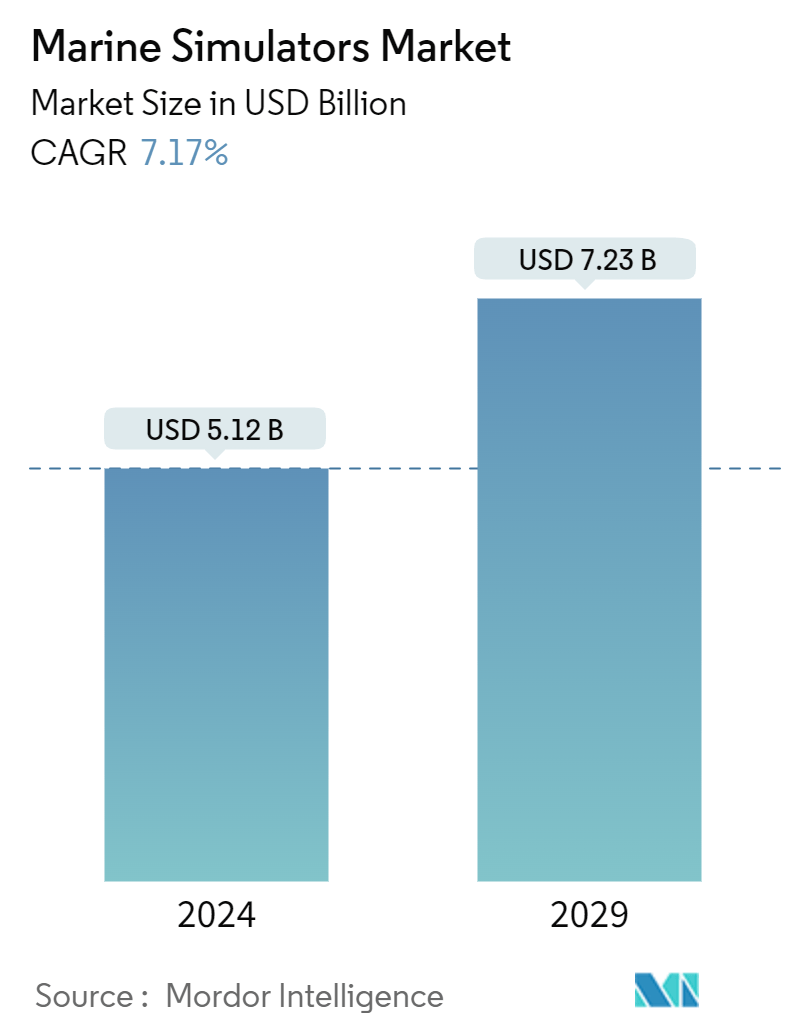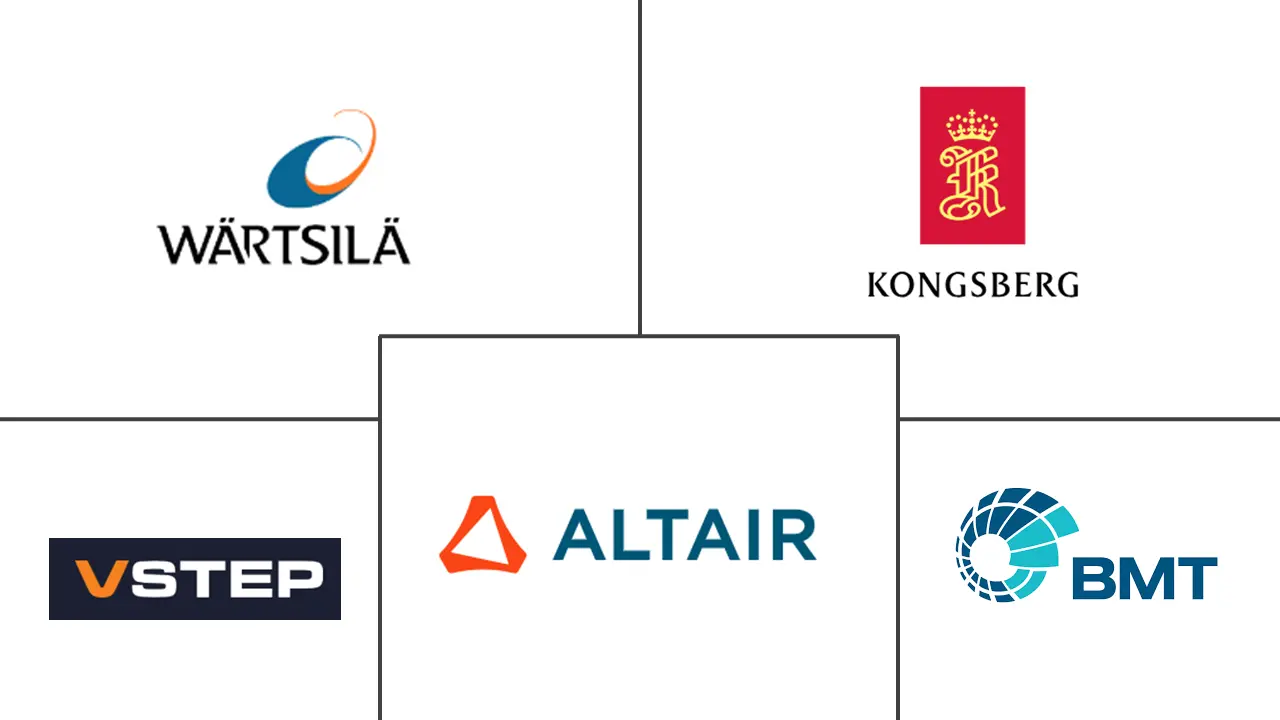Market Size of Marine Simulators Industry

| Study Period | 2019 - 2029 |
| Market Size (2024) | USD 5.12 Billion |
| Market Size (2029) | USD 7.23 Billion |
| CAGR (2024 - 2029) | 7.17 % |
| Fastest Growing Market | Europe |
| Largest Market | North America |
| Market Concentration | High |
Major Players
*Disclaimer: Major Players sorted in no particular order |
Marine Simulators Market Analysis
The Marine Simulators Market size is estimated at USD 5.12 billion in 2024, and is expected to reach USD 7.23 billion by 2029, growing at a CAGR of 7.17% during the forecast period (2024-2029).
Naval forces stationed at sea boundaries are pivotal in national defense, where they navigate unpredictable currents. This underscores the growing importance of training to safeguard ships and personnel. Consequently, nations such as India, China, and the United Kingdom are ramping up their use of ship simulators, fueling the marine simulators market. Modern ships feature advanced communication systems and sensors, heightening operational complexity. Consequently, training crews, maintainers, and ship operators with cutting-edge simulator solutions has become imperative to align personnel with evolving technologies.
The rising need for enhanced training to reduce offshore accidents is driving the establishment of new training facilities worldwide. In recent years, the power and transportation industries have increasingly relied on oil and gas, prompting offshore exploration giants such as ExxonMobil and Royal Dutch Shell to intensify their drilling activities. These operations, conducted beneath the seabed, are notably intricate, given the challenges posed by severe weather conditions like hurricanes and high winds. Consequently, ship operators have prioritized rigorous training. However, the high costs of manufacturing marine simulators are expected to challenge the market growth.
Marine Simulators Industry Segmentation
Maritime simulators replicate ships and maritime settings, serving training, research, and operational needs. They train maritime professionals in ship handling, navigation, and operations, offering a lifelike training environment.
The marine simulator market is segmented by type, application, end use, and geography. By type, the market is segmented into ship bridge simulators, engine room simulators, cargo handling simulators, communication/ global maritime distress and safety system (GMDSS) simulators, and other types. By application, the market is segmented by training and education, fleet operations, and port and terminal operations. By end use, the market is segmented into commercial and military. The report also covers the market sizes and forecasts for the marine simulator market in major countries across different regions. For each segment, the market size and forecast are provided in terms of value (USD).
| By Type | |
| Ship Bridge Simulators | |
| Engine Room Simulators | |
| Cargo Handling Simulators | |
| Communication/ Global Maritime Distress and Safety System (GMDSS) Simulators | |
| Other Types |
| By Application | |
| Training and Education | |
| Fleet Operations | |
| Port and Terminal Operations |
| By End Use | |
| Commercial | |
| Military |
| Geography | |||||||
| |||||||
| |||||||
| |||||||
| |||||||
|
Marine Simulators Market Size Summary
The marine simulators market is poised for significant growth, driven by the increasing need for advanced training solutions to enhance naval capabilities and ensure maritime safety. As countries like India, China, and the United Kingdom invest in modernizing their naval fleets, the demand for sophisticated ship simulators is on the rise. These simulators are crucial for training personnel to operate modern vessels equipped with advanced communication systems and sensors. The market is further bolstered by the rising need to reduce offshore accidents, prompting the establishment of new training facilities globally. However, the high costs associated with manufacturing marine simulators pose a challenge to market expansion.
In North America, particularly the United States, the strategic importance of extensive coastlines and key international waterways has led to increased funding for maritime officer training. The US Navy's plans to expand its fleet and modernize training systems are expected to enhance the region's share in the marine simulator market. The market is semi-consolidated, with key players like Wärtsila Corporation, VSTEP BV, and Kongsberg Gruppen ASA leading the industry. These companies are focusing on mergers and acquisitions to expand their market reach and enhance their product offerings. The continuous demand for training military personnel, driven by geopolitical tensions and the need for advanced naval capabilities, is expected to sustain the market's growth trajectory.
Marine Simulators Market Size - Table of Contents
-
1. MARKET DYNAMICS
-
1.1 Market Overview
-
1.2 Market Drivers
-
1.3 Market Restraints
-
1.4 Porter's Five Forces Analysis
-
1.4.1 Threat of New Entrants
-
1.4.2 Bargaining Power of Buyers/Consumers
-
1.4.3 Bargaining Power of Suppliers
-
1.4.4 Threat of Substitute Products
-
1.4.5 Intensity of Competitive Rivalry
-
-
-
2. MARKET SEGMENTATION
-
2.1 By Type
-
2.1.1 Ship Bridge Simulators
-
2.1.2 Engine Room Simulators
-
2.1.3 Cargo Handling Simulators
-
2.1.4 Communication/ Global Maritime Distress and Safety System (GMDSS) Simulators
-
2.1.5 Other Types
-
-
2.2 By Application
-
2.2.1 Training and Education
-
2.2.2 Fleet Operations
-
2.2.3 Port and Terminal Operations
-
-
2.3 By End Use
-
2.3.1 Commercial
-
2.3.2 Military
-
-
2.4 Geography
-
2.4.1 North America
-
2.4.1.1 United States
-
2.4.1.2 Canada
-
-
2.4.2 Europe
-
2.4.2.1 Germany
-
2.4.2.2 United Kingdom
-
2.4.2.3 Russia
-
2.4.2.4 France
-
2.4.2.5 Rest of Europe
-
-
2.4.3 Asia-Pacific
-
2.4.3.1 India
-
2.4.3.2 China
-
2.4.3.3 Japan
-
2.4.3.4 South Korea
-
2.4.3.5 Rest of Asia-Pacific
-
-
2.4.4 Latin America
-
2.4.4.1 Brazil
-
2.4.4.2 Rest of Latin America
-
-
2.4.5 Middle East and Africa
-
2.4.5.1 United Arab Emirates
-
2.4.5.2 Saudi Arabia
-
2.4.5.3 Israel
-
2.4.5.4 Rest of Middle East and Africa
-
-
-
Marine Simulators Market Size FAQs
How big is the Marine Simulators Market?
The Marine Simulators Market size is expected to reach USD 5.12 billion in 2024 and grow at a CAGR of 7.17% to reach USD 7.23 billion by 2029.
What is the current Marine Simulators Market size?
In 2024, the Marine Simulators Market size is expected to reach USD 5.12 billion.

